Unit 6 Keep our city clean 教案
文档属性
| 名称 | Unit 6 Keep our city clean 教案 | 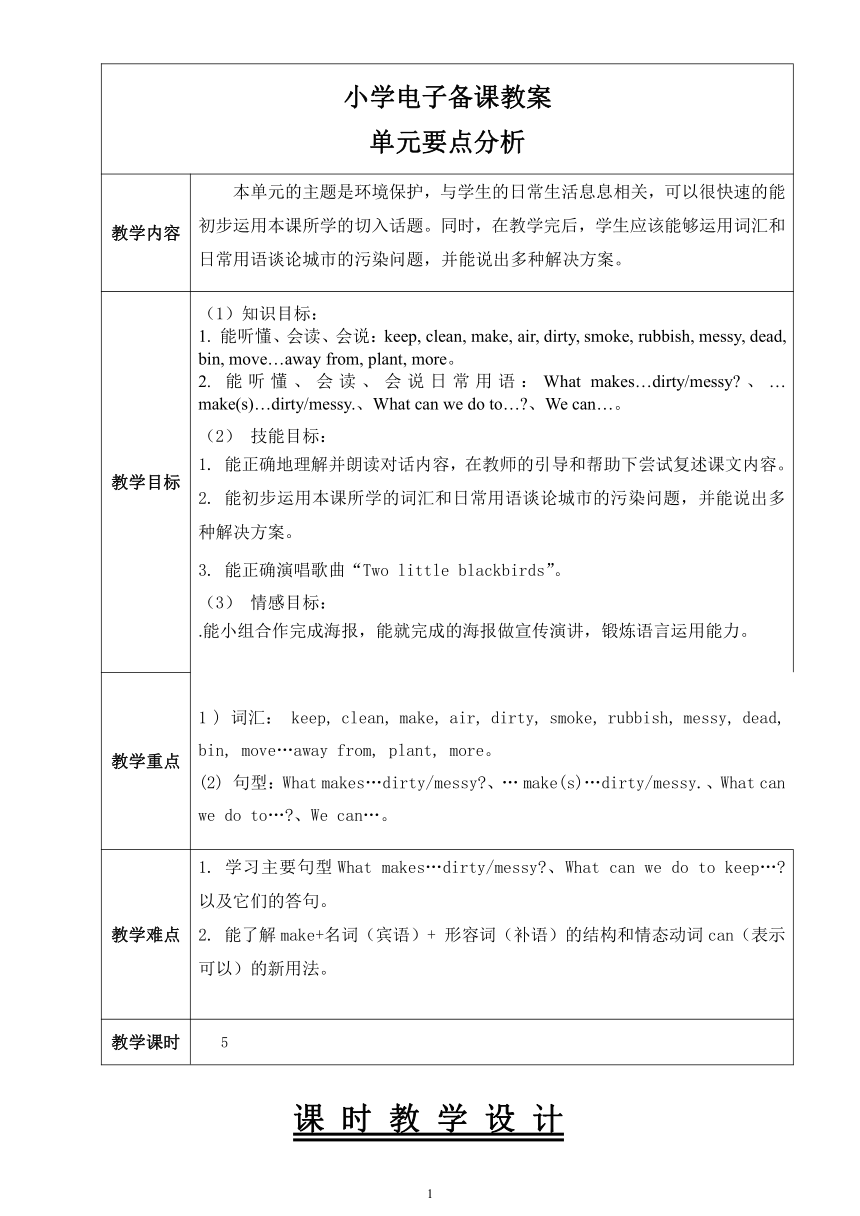 | |
| 格式 | zip | ||
| 文件大小 | 28.2KB | ||
| 资源类型 | 教案 | ||
| 版本资源 | 牛津译林版 | ||
| 科目 | 英语 | ||
| 更新时间 | 2018-10-16 13:15:07 | ||
图片预览

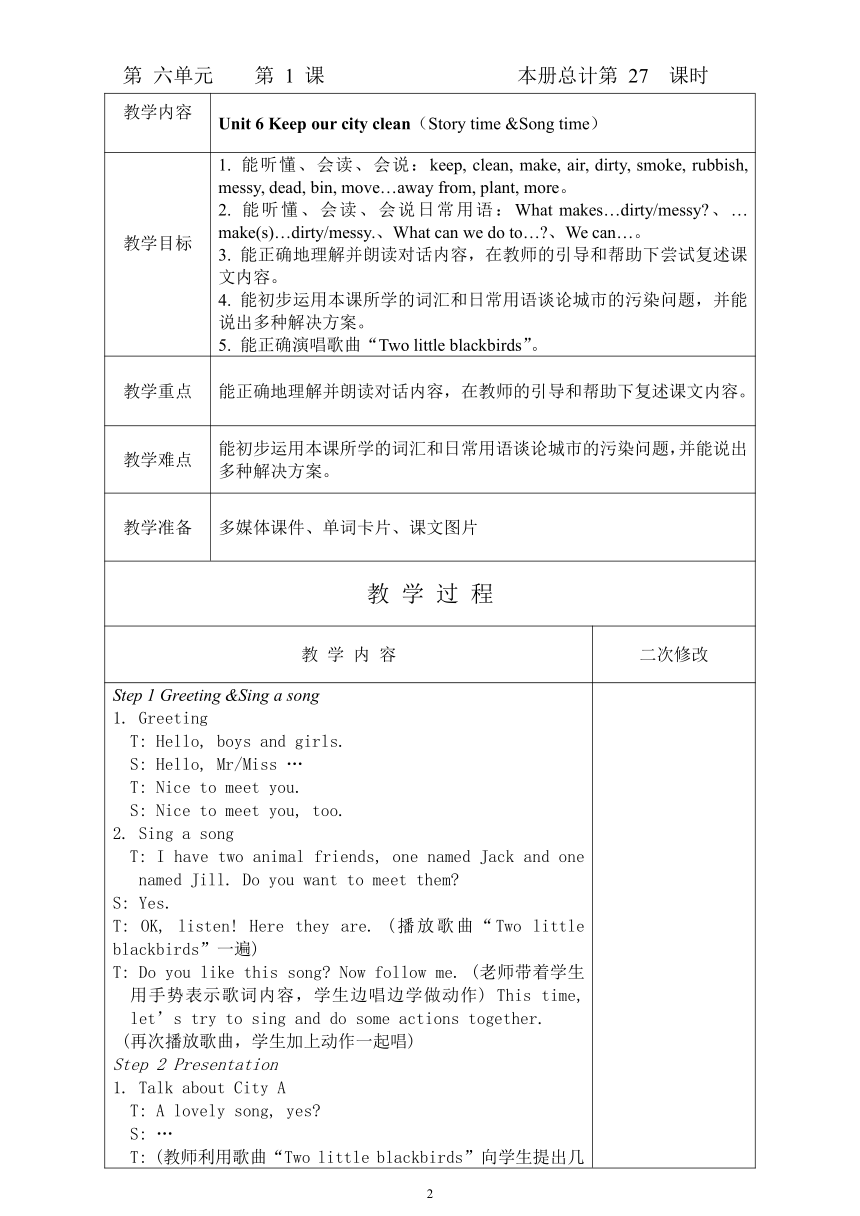
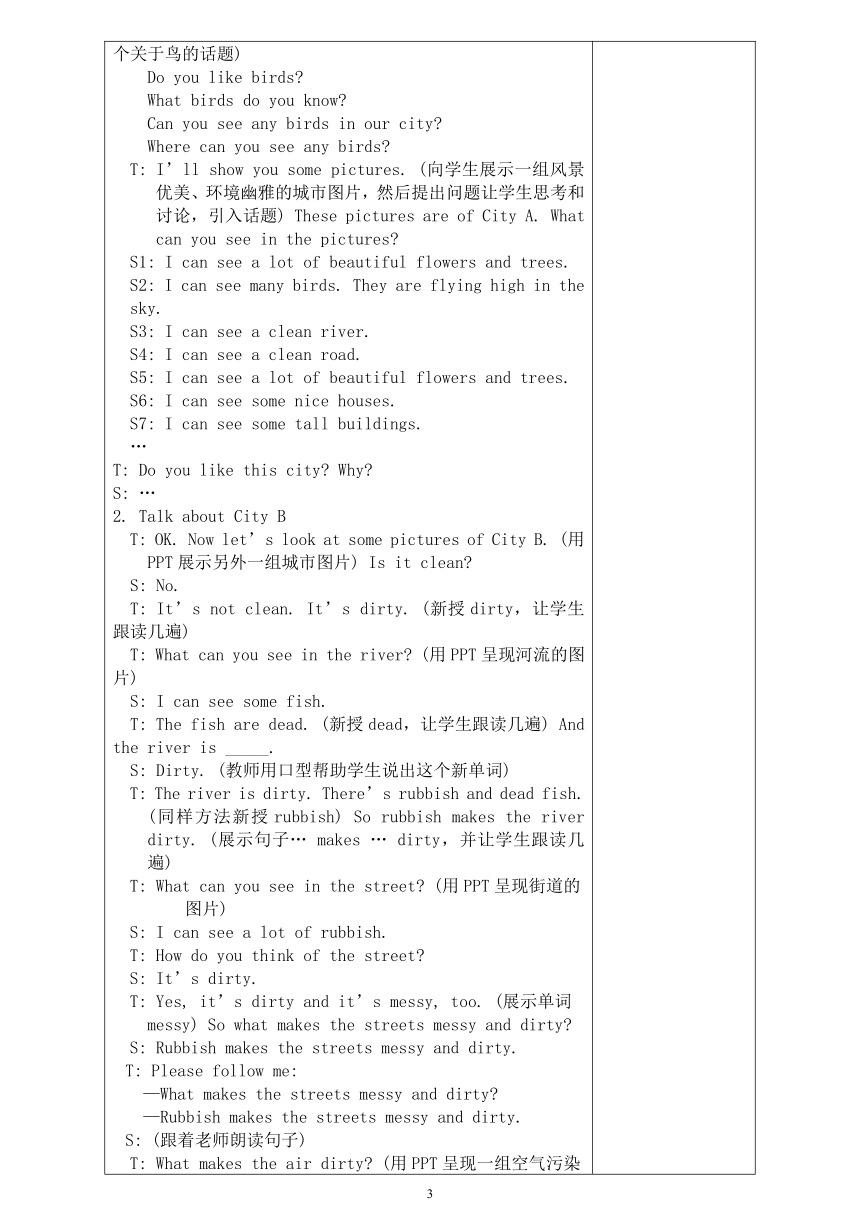
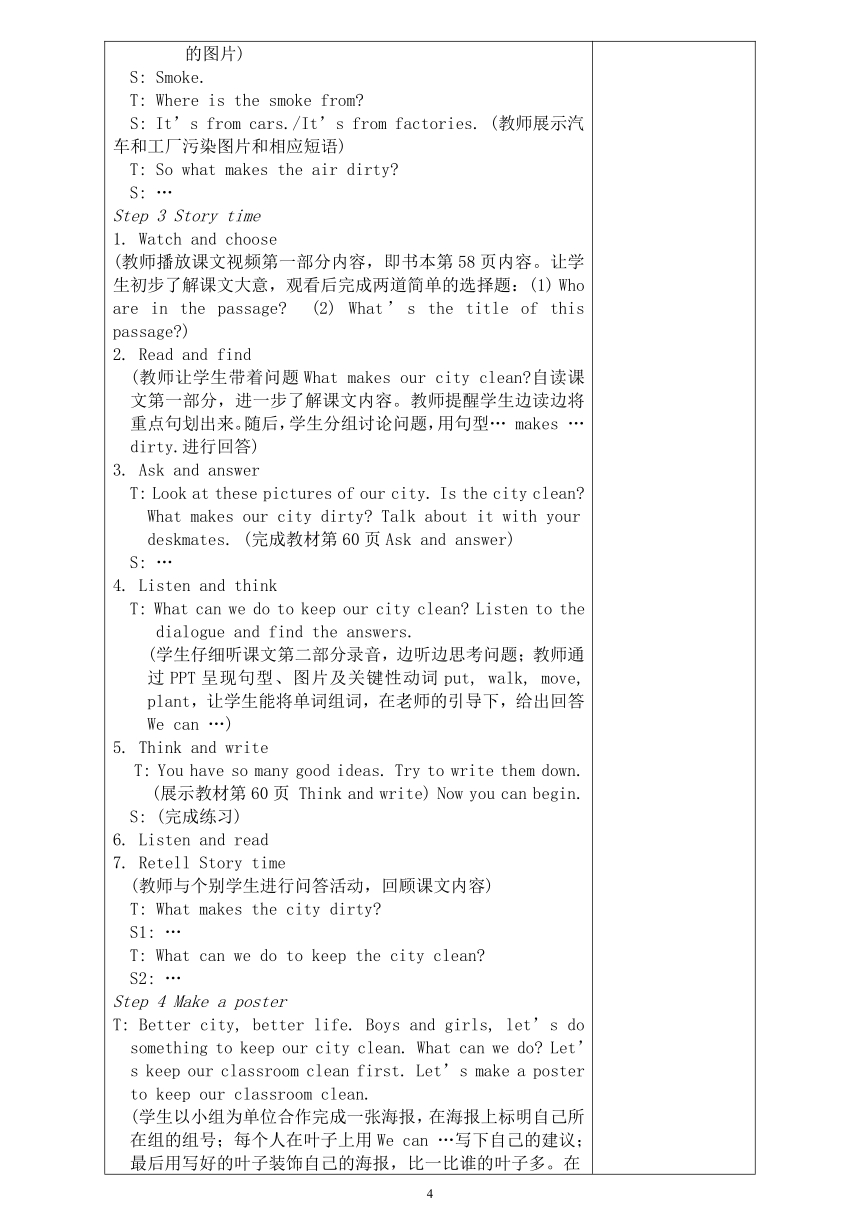
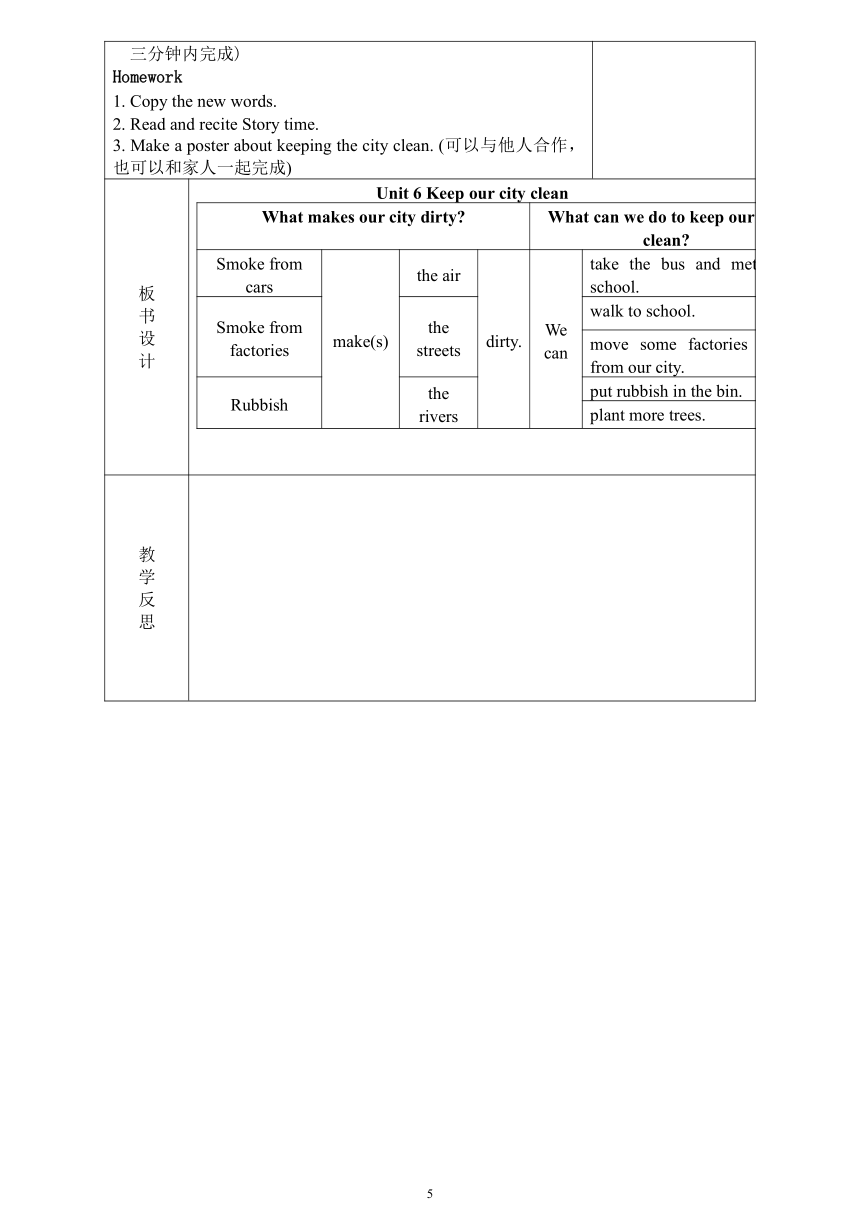
文档简介
小学电子备课教案 单元要点分析
教学内容
本单元的主题是环境保护,与学生的日常生活息息相关,可以很快速的能初步运用本课所学的切入话题。同时,在教学完后,学生应该能够运用词汇和日常用语谈论城市的污染问题,并能说出多种解决方案。
教学目标
(1)知识目标:
1. 能听懂、会读、会说:keep, clean, make, air, dirty, smoke, rubbish, messy, dead, bin, move…away from, plant, more。
2. 能听懂、会读、会说日常用语:What makes…dirty/messy?、… make(s)…dirty/messy.、What can we do to…?、We can…。
(2) 技能目标:
1. 能正确地理解并朗读对话内容,在教师的引导和帮助下尝试复述课文内容。
2. 能初步运用本课所学的词汇和日常用语谈论城市的污染问题,并能说出多种解决方案。
3. 能正确演唱歌曲“Two little blackbirds”。
(3) 情感目标:
.能小组合作完成海报,能就完成的海报做宣传演讲,锻炼语言运用能力。
教学重点
1 ) 词汇: keep, clean, make, air, dirty, smoke, rubbish, messy, dead, bin, move…away from, plant, more。
(2) 句型:What makes…dirty/messy?、… make(s)…dirty/messy.、What can we do to…?、We can…。
教学难点
1. 学习主要句型What makes…dirty/messy?、What can we do to keep…?以及它们的答句。
2. 能了解make+名词(宾语)+ 形容词(补语)的结构和情态动词can(表示可以)的新用法。
教学课时
5
课 时 教 学 设 计
第 六单元 第 1 课 本册总计第 27 课时
教学内容
Unit 6 Keep our city clean(Story time &Song time)
教学目标
1. 能听懂、会读、会说:keep, clean, make, air, dirty, smoke, rubbish, messy, dead, bin, move…away from, plant, more。
2. 能听懂、会读、会说日常用语:What makes…dirty/messy?、… make(s)…dirty/messy.、What can we do to…?、We can…。
3. 能正确地理解并朗读对话内容,在教师的引导和帮助下尝试复述课文内容。
4. 能初步运用本课所学的词汇和日常用语谈论城市的污染问题,并能说出多种解决方案。
5. 能正确演唱歌曲“Two little blackbirds”。
教学重点
能正确地理解并朗读对话内容,在教师的引导和帮助下复述课文内容。
教学难点
能初步运用本课所学的词汇和日常用语谈论城市的污染问题,并能说出多种解决方案。
教学准备
多媒体课件、单词卡片、课文图片
教 学 过 程
教 学 内 容
二次修改
Step 1 Greeting &Sing a song
1. Greeting
T: Hello, boys and girls.
S: Hello, Mr/Miss …
T: Nice to meet you.
S: Nice to meet you, too.
2. Sing a song
T: I have two animal friends, one named Jack and one named Jill. Do you want to meet them?
S: Yes.
T: OK, listen! Here they are. (播放歌曲“Two little blackbirds”一遍)
T: Do you like this song? Now follow me. (老师带着学生用手势表示歌词内容,学生边唱边学做动作) This time, let’s try to sing and do some actions together.
(再次播放歌曲,学生加上动作一起唱)
Step 2 Presentation
1. Talk about City A
T: A lovely song, yes?
S: …
T: (教师利用歌曲“Two little blackbirds”向学生提出几个关于鸟的话题)
Do you like birds?
What birds do you know?
Can you see any birds in our city?
Where can you see any birds?
T: I’ll show you some pictures. (向学生展示一组风景优美、环境幽雅的城市图片,然后提出问题让学生思考和讨论,引入话题) These pictures are of City A. What can you see in the pictures?
S1: I can see a lot of beautiful flowers and trees.
S2: I can see many birds. They are flying high in the sky.
S3: I can see a clean river.
S4: I can see a clean road.
S5: I can see a lot of beautiful flowers and trees.
S6: I can see some nice houses.
S7: I can see some tall buildings.
…
T: Do you like this city? Why?
S: …
2. Talk about City B
T: OK. Now let’s look at some pictures of City B. (用PPT展示另外一组城市图片) Is it clean?
S: No.
T: It’s not clean. It’s dirty. (新授dirty,让学生跟读几遍)
T: What can you see in the river? (用PPT呈现河流的图片)
S: I can see some fish.
T: The fish are dead. (新授dead,让学生跟读几遍) And the river is _____.
S: Dirty. (教师用口型帮助学生说出这个新单词)
T: The river is dirty. There’s rubbish and dead fish. (同样方法新授rubbish) So rubbish makes the river dirty. (展示句子… makes … dirty,并让学生跟读几遍)
T: What can you see in the street? (用PPT呈现街道的图片)
S: I can see a lot of rubbish.
T: How do you think of the street?
S: It’s dirty.
T: Yes, it’s dirty and it’s messy, too. (展示单词messy) So what makes the streets messy and dirty?
S: Rubbish makes the streets messy and dirty.
T: Please follow me:
—What makes the streets messy and dirty?
—Rubbish makes the streets messy and dirty.
S: (跟着老师朗读句子)
T: What makes the air dirty? (用PPT呈现一组空气污染的图片)
S: Smoke.
T: Where is the smoke from?
S: It’s from cars./It’s from factories. (教师展示汽车和工厂污染图片和相应短语)
T: So what makes the air dirty?
S: …
Step 3 Story time
1. Watch and choose
(教师播放课文视频第一部分内容,即书本第58页内容。让学生初步了解课文大意,观看后完成两道简单的选择题:(1) Who are in the passage? (2) What’s the title of this passage?)
2. Read and find
(教师让学生带着问题What makes our city clean?自读课文第一部分,进一步了解课文内容。教师提醒学生边读边将重点句划出来。随后,学生分组讨论问题,用句型… makes … dirty.进行回答)
3. Ask and answer
T: Look at these pictures of our city. Is the city clean? What makes our city dirty? Talk about it with your deskmates. (完成教材第60页Ask and answer)
S: …
4. Listen and think
T: What can we do to keep our city clean? Listen to the dialogue and find the answers.
(学生仔细听课文第二部分录音,边听边思考问题;教师通过PPT呈现句型、图片及关键性动词put, walk, move, plant,让学生能将单词组词,在老师的引导下,给出回答We can …)
5. Think and write
T: You have so many good ideas. Try to write them down. (展示教材第60页 Think and write) Now you can begin.
S: (完成练习)
6. Listen and read
7. Retell Story time
(教师与个别学生进行问答活动,回顾课文内容)
T: What makes the city dirty?
S1: …
T: What can we do to keep the city clean?
S2: …
Step 4 Make a poster
T: Better city, better life. Boys and girls, let’s do something to keep our city clean. What can we do? Let’s keep our classroom clean first. Let’s make a poster to keep our classroom clean.
(学生以小组为单位合作完成一张海报,在海报上标明自己所在组的组号;每个人在叶子上用We can …写下自己的建议;最后用写好的叶子装饰自己的海报,比一比谁的叶子多。在三分钟内完成)
Homework
1. Copy the new words.
2. Read and recite Story time.
3. Make a poster about keeping the city clean. (可以与他人合作,也可以和家人一起完成)
板
书
设
计
Unit 6 Keep our city clean
What makes our city dirty?
What can we do to keep our city clean?
Smoke from cars
make(s)
the air
dirty.
We can
take the bus and metro to school.
Smoke from factories
the streets
walk to school.
move some factories away from our city.
Rubbish
the rivers
put rubbish in the bin.
plant more trees.
教
学
反
思
课 时 教 学 设 计
第六 单元 第 2 课 本册总计第 28 课时
教学内容
Unit 6 Keep our city clean
教
学
目
标
1. 学习主要句型What makes…dirty/messy?、What can we do to keep…?以及它们的答句。
2. 能了解make+名词(宾语)+ 形容词(补语)的结构和情态动词can(表示可以)的新用法。
3. 能通过创设的情景帮助学生正确运用本课所学的语言。
教学重点
能掌握并熟练运用句型What makes…dirty/messy?、What can we do to keep…?以及它们的答句。
教学难点
能正确理解并运用本课归纳的语法:make + 名词(宾语)+ 形容词(补语)。
教学准备
多媒体课件、单词卡片
教 学 过 程
教 学 内 容
二次修改
Step 1 Greeting
1. Greeting
T: Good morning, boys and girls.
S: Good morning, Mr/Miss …
2. Free talk
T: What’s the weather like today in Suzhou?
S: It’s…
T: OK! How do you think about our city? Do you think it is clean or dirty? Why?
S: I think it’s clean, because…/I don’t think it’s clean. I think it’s dirty, because…
(让学生就我们城市整洁与否进行讨论并说出理由
Step 2 Revision
1. Review Part One of Story time
T: Our city is not very clean now, and what makes it dirty? Here four pictures will help you. Look at them and discuss.
S: … (两人一组进行讨论)
T: (逐一呈现问题)
(1) What makes the air dirty?
(2) What makes the streets messy and dirty?
(3) What makes the river dirty?
S: (逐一回答问题)
(1) Smoke from cars makes the air dirty.
Black smoke from factories makes the air dirty.
(2) Rubbish makes the streets messy and dirty.
(3) The rubbish in the water and the dead fish make the river dirty.
T: (教师将学生的回答整理、合并,完整呈现课文第一部分)
So, what makes our city dirty? (给学生一至两分钟时间准备,要求学生完整回答此问题)
S: Smoke from cars makes the air dirty. Black smoke from factories makes the air dirty. Rubbish makes the streets messy and dirty. The rubbish in the water and the dead fish make the river dirty.
2. Review Part Two of Story time
T: (教师提出两个问题让学生讨论)
Q1: Who makes our city dirty?
Q2: Who keeps our city clean?
S: (回答问题)
People make our city dirty.
The cleaners make our city clean. (在教师的引导下说出cleaner:teach—teacher, clean—cleaner)
T: (Show the pictures of the cleaners) What can we do to keep our city clean?
S: We can… (学生先讨论回答,然后完成填空练习)
Step 3 Grammar time
1. Presentation
T: You’ve done a very good job. Here’s a present for you. What’s it?
S: It’s a magic wand. (在教师的提示和帮助下理解magic wand)
T: Yes, it’s a magic wand. It has magic. Let’s have a try.Long, long, make the wand long. Short, short, make the wand short. Is it magical?
S: Yes.
T: If you want to use the magic wand, please remember the magic password. Long, long, make the wand long.
[板书:make+名词(宾语)+形容词(补语),并讲解:名词通常是make这个动作执行的对象,我们称它为宾语]
S: [学生反复操练该口令,并逐步记住这个短语结构:make+名词(宾语)+形容词(补语)]
2. Practice (Read a story)
T: OK, you know the password; let’s know more about the wand. Read the story and find more passwords in the story.
S: [阅读故事,找出make+名词(宾语)+形容词的结构,并尽可能自己说出口令,如Colourful, colourful, make Tina’s clothes colourful.]
make Tina small,
make Tina big,
make me small,
make you small,
make me happy,
make your clothes colourful,
make her very excited,
make the world beautiful.
T: Is the story interesting?
S: Yes.
T: Let’s go on to read the story. (继续呈现故事:Bobby and Tina went to the park. They wanted to make the park more beautiful. What can they do to make the park more beautiful? )
S: Trees, trees, make the park green.
Lake, lake, make the park beautiful.
Flowers, flowers, make the park colourful.
T: Now the park is beautiful. But what can we do to keep the park beautiful?Tina was worried about it. Bobby had a good idea. Can you help them? You can talk with your partners: What can we do to keep the park beautiful?
S: We can plant…/We can water…/We can keep…clean.
We can’t walk/pick/climb/litter…
3. Production
T: More and more people came to the park. They walked on the grass, climbed the tree, picked flowers and littered on the grass. The park was dirty and messy. Bobby and Tina knew the wand could make the park beautiful. But it couldn’t keepit beautiful. What could they do to keep the park clean and beautiful? Bobby and Tina had a good idea. Let’s read their proposal(倡议书).
S: (朗读倡议书)
Let’s keep the park beautiful
Dear friends,
The trees are green. The flowers are colourful. They make the park beautiful. They make us happy. So please don’t walk on the grass. Don’t pick flowers in the park. Don’t climb the trees. Let’s plant more trees and flowers. Let’s water the trees and flowers together.
The lake is clean. The grass is beautiful. They make the air clean. They make us healthy. So please don’t throw rubbish into the lake. Don’t litter on the grass. We can put the rubbish in the bin. We can pick the rubbish with our classmates at the weekends.
Come on, everybody. Join us. Let’s keep the park clean. Let’s keep the park beautiful. Let’s make our life more colourful.
Bobby and Tina
T: (指导学生读倡议书,理解内容后,布置小练习) This is Bobby and Tina’s proposal. What about yours? Please write a proposal by yourself.
S: (独立完成练习)
_______ make(s)_____________.
To keep the park more beautiful, we can______________________.
We can’ t ____________________.
T: (指导学生完成练习,请学生分享自己的倡议书)
Step 4 Consolidation
T: If we can do it like this, many places in our city will be beautiful. Our city willbecome better and better. To create the National Health City, start from me.
S: To create the National Health City, start from me. (在教师的帮助下读出来这句话,并理解其含义)
T: Let’s enjoy the beautiful scenery in XuYi. (播放一组盱眙风景图)
Homework 家庭作业
1. Copy the sentence patterns.
2. Discuss with your family about how to keep our city clean.
板
书
设
计
Unit 6 Keep our city clean
What makes our city dirty? The password
make Tina small,
make Tina big,
make me small,
make you small,
What can we do to keep our city clean?make me happy,
make your clothes colourful,
make her very excited,
make the world beautiful.
教
学
反
思
课 时 教 学 设 计
第六单元 第 3 课 本册总计第 29 课时
教学内容
Unit 6 Keep our city clean (Fun time)
教
学
目
标
1.通过海报的制作和演讲的展示巩固本单元主要句型What makes…dirty/messy?、What can we do to…?,以及保护环境的一些相关短语。
2.能进一步深化了解及运用make+名词(宾语)+形容词(补语)的结构和情态动词can(表示可以)的新用法。
3.能小组合作完成海报,能就完成的海报做宣传演讲,锻炼语言运用能力。
教学重点
1. 学生能正确读出本课重要句型What does it mean? It means….
并能在生活中灵活运用。
2. 学生能掌握字母组合ir的发音。
3. 通过学习学生能熟练地朗诵cartoon time.
教学难点
能掌握并熟练运用句型What can we do to keep…?,以及其答句We can…
教学准备
多媒体课件、图片
教 学 过 程
教 学 内 容
二次修改
Step 1 Greeting
T: Hello, boys and girls. How are you?
S: …
T: Today we’ll come to Unit 6 Keep our city clean, Fun time.
Step 2 Revision
1. Play a game
T: Boys and girls, let’s play a game first. Turn the turntable, and then use the word to make a dialogue.
S: (使用messy/dirty/crowded/smelly等词) What makes our city…?、…make(s) our city…。
2. Ask and answer
T: So, our city is not clean. What can we do to keep our city clean?
S:We can take the bus and metro to school.
We can walk to school.
We can move some factories away from our city.
We can put rubbish in the bin.
We can plant more trees.
Step 3 Fun time
1. Presentation
T: First, let’s enjoy some pictures of our school. We study in a beautiful school. We have many bright classrooms, some beautiful gardens and a big playground. (展示学校的美图)
But some of our students do bad things at school. (展示图片和词组结构,让学生描述出来) They throw the rubbish on the floor, draw on the walls and desks, pick flowers, climb trees, walk on the grass, put rubbish everywhere andstand on the chairs.
Now our school is not clean. We study in the dirty and messy school. What can we do to keep our school clean?
S: (观赏图片,说出每张图片的主要内容) We can sweep the floor, put rubbish in the bin, clean the desks and chairs, and clean the windows.
2. Practice (Make a poster)
T: To keep our school clean, we should do something. Let’s make a poster. OK?Look! I have a big tree. But it doesn’t have any leaves. Let’s make the tree beautiful. There are many pictures of leaves. Let’s write down some activities we can do at school on the leaves.
S: (写词组)
T: Then put the leaves on the trees.
S: (将树叶一一展示在树上)
T: Now you can make a poster in groups. These phrases will help you.
sweep the floor, put rubbish in the bin
clean the desks and chairs, clean the windows, clean the blackboard, clean the door
pick up the rubbish, plant more trees
keep the wall clean, keep the classroom clean, keep off the grass
make signs like “No littering”, “No smoking” and “No climbing”
3. Production
T: Let’s look at the tree and try to make a speech to invite more students to join us. Now, here’s a speech. Please read it.
S: (朗读演讲稿)
Let’s keep our school clean
We study in a beautiful school. We have bright classrooms, beautiful gardens anda big playground. But now our school is not clean.
What makes our school dirty? Some of our students do bad things at school. They throw the rubbish on the floor, draw on the walls and desks, pick flowers, climbtrees, walk on the grass, put rubbish everywhere and stand on the chairs. We study in the dirty and messy school. How do you feel? Are you happy?
What can we do to keep our school clean? I think we can sweep the floor, put rubbish in the bin, clean the desks and chairs and clean the windows. We can clean the blackboard, clean the door, pick up the rubbish, plant more trees, keep the walls clean, keep the classroom clean, keep off the grass and make signs like “No littering”, “No smoking” and “No climbing”.
Come on, everybody. Join us. Let’s try our best to keep our school clean!
T: Let’s give a speech with this topic. But, how can we make a speech? Here’s a tip for you:
我们以环保为主题做一个演讲。在演讲前,我们需要搜集相关的资料,然后在分析资料的基础上列一个提纲,再根据提纲进行阐述,这样就会使自己的演讲条理清楚。
(引出演讲主题背景) We study in a beautiful school. We have…But now…
(分析主要问题原因) What makes our school dirty? Some of our students do bad things at school. They…
(阐明解决办法) What can we do to keep our school clean? I think we can…We can’t…
(呼吁倡议) Come on, everybody. Join us. Let’s try our best to…
Now prepare the speech in groups, please.
S: (以小组为单位,共同探讨和完成演讲稿)
T: Who can give us a speech? Have a try.
S: (一至两名学生发表演讲)
T: (就学生演讲提出一些建议)
Step 4 Conclusion
T: Well done. Now let’s look at the school again. It becomes clean and beautiful. More and more students join us. They know we should take good care of our school. Let’s keep the school clean. Let’s make the school more beautiful.
Homework
1. Improve the poster and put it up in our school.
2. Finish the writing and give a speech to your family.
板
书
设
计
Unit6 Keep our city clean
Let’s keep our school clean
教
学
反
思
课 时 教 学 设 计
第 六单元 第 4 课 本册总计第 30 课时
教学内容
Unit 6 Keep our city clean(Sound time & Song time)
教
学
目
标
1. 学会表演唱歌曲,并能试着创编歌曲唱。
2. 能根据升调和降调规律,读出小韵文。
3. 学会如何使用升降调。
教学重点
能使用正确的升降调,会表演唱歌曲,并能试着创编歌曲唱。
教学难点
能根据图片表达自己的观点。
教学准备
图片、视频、PPT 、录音机
教 学 过 程
教 学 内 容
二次修改
Step 1 Greeting
T: Hello, boys and girls. How are you?
S: Fine, thank you.
T: Today we’ll come to Unit 6 Keep our city clean, Sound time & Song time.
Step 2 Song time
1. T: Look, I have two blackbirds. They are sitting on the hill. Let’s enjoy. (展示小鸟手势表演,演示朗读歌词)
Two little blackbirds sitting on the hill, one named Jack and one named Jill.
Fly away, Jack. Fly away, Jill. Come back, Jack and come back, Jill.
Two little blackbirds sitting on the hill. One named Jack and one named Jill.
Follow me to do the action with our hands and read. (做手语读歌词)
2. T: Look at these phrases. Try to read them.
two little blackbirdssitting on the hill one named …
fly away come back
(展示图片帮助理解)
3. T: Let’s watch the cartoon and try to sing after it.
4. T: Let’s act and sing.
S:…
T: Let’s make a song and sing. For example:
Two little blackbirds sitting in the tree, one named Jack and one named Jill.
Too many cars, too much smoke.
Fly away, Jack. Fly away, Jill.
Two little blackbirds sitting in the tree, one named Jack and one named Jill.
No more cars, no more smoke.
Come back, Jack. Come back, Jill.
Let’s change to sing in pairs.(请同学一起试着换掉歌词的一部分再唱)
Step 3 Sound time
1. T: In our city, we can’t see many birds, because the city is not clean. It’s not good for the birds to live. So can we throw rubbish on the floor?
S: No.
T: Do you throw rubbish on the floor?
S: No, I don’t. I put my rubbish in the bin.
T: Can we keep our city clean?
S: Yes, we can. We can put our rubbish in the bin.
T: That’s true. Now let’s listen to a rhyme. Pay attention to rising and falling intonation. (展示小韵文)
Boys and girls, do you know the rising and falling intonation?Now look at the rhyme. Can you find the rising and falling intonation?
S: Sentence 1: Do you throw rubbish on the floor? (闪烁升降调标记)
T: Yes. What else?
S: Sentence 4: Can we put our rubbish in the bin?
T: Yes. We should use the rising intonation when we read the first sentence and the fourth sentence. We should use the falling intonation when we read the other sentences.
2. T: When can we use the rising intonation? When can we use the falling intonation?
Here’s the table for you. (展示板书)
英语朗读时语调来自于音调的变化,以降调和升调为两种基本语调。
使用范围和表达含义
句子类型
例句
降调
降调一般用于陈述、命令,表达“完整”、“肯定”的含义
陈述句
I am a student.
特殊疑问句
What are you?
祈使句
Let’s go.
感叹句
What a good student!
升调
用于提问等,表达“不肯定”、“礼貌”、“委婉”的含义
一般疑问句:句尾用升调
Are you a student?
反意疑问句:疑问部分用升调,表示不肯定
You are a student, aren’t you?
选择疑问句:前半句读升调,后半句读降调
Are you a student or a teacher?
T: Are you clear?
3. T: Now we know how to use the rising and falling intonation. Let’s try to read these sentences. (展示句子)
(1) Be careful, Tim! (祈使句)
(2) Can you see the sign? (一般疑问句)
(3) What does it mean? (特殊疑问句)
(4) It means the floor is wet. (陈述句)
Well done. For Sentences 1, 3 and 4, we should use the falling intonation. And for Sentence 2, we should use the rising intonation. Try to read again.
4. T: 其实在英文的朗读中除了一般疑问句、反意疑问句和选择疑问句中要读升调,还有一些地方要注意读升调,比如长句子中间停顿读升调,结束读降调。如:We can take the bus and the metro to school. 还有A,B,C and D 一句中 A, B, C用升调,D用降调,如one, two, three, four and five,and之前的都需要读升调,five则要读降调。同学们,在今后的学习中,我们自己要慢慢体会并掌握哦
Step 4 Consolidation
T: So you’ve done a very good job. Now, let’s enjoy the pictures by yourselves. (按顺序播放学生的环保画)
P1. The water is clean. The children are fishing.
P2. Rubbish makes the sea dirty. The octopuses (章鱼) are busy.
P3. The fish are swimming away because the water is dirty.
P4. The fish are dead because the water is dirty.
P5. The trees and grass are green. The flowers are beautiful. The girl is happy.
P6. The children are watering the trees and flowers. The flowers are beautiful and the children are happy.
P7. People cut down too many trees.
P8. The birds are crying because there are no trees.
P9. The lion is crying because there are no trees in the forest.
P10. The birds are crying because they have no home.
P11. The air is dirty. The birds are flying away.
P12. The Earth is crying.
P13. The Earth is our home. We can’t live without it. We should do something to protect it.
P14. Keep smoke away from our life; let the Earth become more beautiful.
P15. Let’s try to be green stars.
P16. We can water the flowers and the grass.
P17. We can put rubbish in the bin, sweep the floor, pick up the banana skin and plant more trees.
P18. We can take the bus and the metro to school. We can ride a bike or walk to school.
P19. We should turn off the light when we leave.
P20. We should turn off the tap after using water.
P21. In this way, the Earth will be more and more beautiful. Look, the fish are singing happily.
P22. My parents and I will go to the park this weekend. We want to enjoy the sunshine and have a happy time.
Homework Write something about your green plan.
板
书
设
计
Unit 6 Keep our city clean
使用范围和表达含义
句子类型
例句
降调
降调一般用于陈述、命令,表达“完整”、“肯定”的含义
陈述句
I am a student.
特殊疑问句
What are you?
祈使句
Let’s go.
感叹句
What a good student!
升调
用于提问等,表达“不肯定”、“礼貌”、“委婉”的含义
一般疑问句:句尾用升调
Are you a student?
反意疑问句:疑问部分用升调,表示不肯定
You are a student, aren’t you?
选择疑问句:前半句读升调,后半句读降调
Are you a student or a teacher?
教
学
反
思
课 时 教 学 设 计
第六 单元 第 5 课 本册总计第 31 课时
教学内容
Unit 6 Keep our city clean (Cartoon time& Checkout time )
教
学
目
标
1. 学习主要短语throw a banana skin on the ground, pick it up, slip on the banana skin and fall。
2. 能通过创设的情景读懂故事,并尝试表演故事,正确运用本课所学的语言。
3. 通过学习故事,明白不能随手乱扔垃圾的道理,养成良好的卫生习惯。
教学重点
通过学习故事,让学生意识到保护环境要从自己做起,从小事做起。
教学难点
理解故事内容,能根据故事回答问题,能熟练运用本课所学语言知识
教学准备
图片、视频、PPT 、录音机
教 学 过 程
教 学 内 容
二次修改
Step 1 Greeting
T: Hello, boys and girls. How are you?
S: Fine, thank you.
T: Today we’ll come to Unit 6 Keep our city clean, Cartoon time.
Step 2 Pre-reading (Part 4 of Cartoon time)
T: Look at Picture 4. Where are Bobby and Billy?
S: They are in the hospital.
T: What’s wrong with Billy?
S: Billy hurts his right leg.
T: How do Billy and Bobby feel?
S: Billy feels angry. Bobby feels sorry.
T: What happens? Can you guess?
S: Maybe Billy falls. Maybe Billy climbs the tree and falls down. Maybe Billy slips …
Step 3 While-reading
1. Part 3 of Cartoon time
T: Great. What happens? Let’s watch a cartoon and then choose one.
A. Billy climbs the tree and falls down.
B. Billy slips on a banana skin and falls.Which one?
S: B.
T: Great. Billy slips on a banana skin and falls. (展示图片及词组slip on a banana skin and fall,帮助理解)
2. Part 2 of Cartoon time
T: Let’s look at Picture 2 and answer the questions.
Q1: Who throws the banana skin on the ground, Bobby or Tina?
Q2: Can Bobby do that?
Q3: What does Tina say to him?
Let’s check.
S: Q1: Bobby.
(教师展示图片和词组throw the banana skin on the ground,帮助理解)
Q2: No.
Q3: Bobby, you shouldn’t do that! Pick it up. It makes the street messy.
(教师展示图片和词组pick it up)
T: What do you want to say to Bobby? Give Bobby some suggestions. You can use the sentences “You should/shouldn’t …”
S: Bobby, you should put rubbish in the bin./Bobby, you shouldn’t throw rubbish on the ground./Bobby, you should keep our city clean …
3. Part 1 of Cartoon time
T: Great. We should keep our city clean. We shouldn’t throw rubbish on the ground. I think our city will be more beautiful. You will like living the city better, right? Bobby and Tina like living the city too. Why? Please listen and try to fill in the blanks.
Bobby likes living in the city because __________________________________.
Tina likes living in the city because __________________________________.
Let’s check. (展示答案)
S: Bobby likes living in the city because there are many museums, shops and cinemas.
Tina likes living in the city because it’s clean and beautiful.
Step 4 Post-reading
1. T: Let’s read after the recorder.
S: (Read Cartoon time)
2. T: Let’s work in fours. (让学生四个一组进行朗读、表演,提醒学生注意表情、动作和语调)
S: …
3. T: Let’s think. What can Bobby do then?
S: He can put the rubbish in the bin/… He can’t throw rubbish on the floor again/…
T: What can we do to keep our city clean?
Homework 家庭作业
1. Read Cartoon time, and try to tell this story to your parents or your friends.
2. Preview Checkout time and finish the exercise in this part. (Pages 66&67)
板
书
设
计
Unit6 Keep our city clean
P1. Why do Bobby and Tina like living in the city?
P2. Who throws a banana skin on the ground? Can he/she do that?
P3. What’s wrong with Billy?
P4. Where are Billy and Bobby? What’s wrong with Billy?
教
学
反
思
